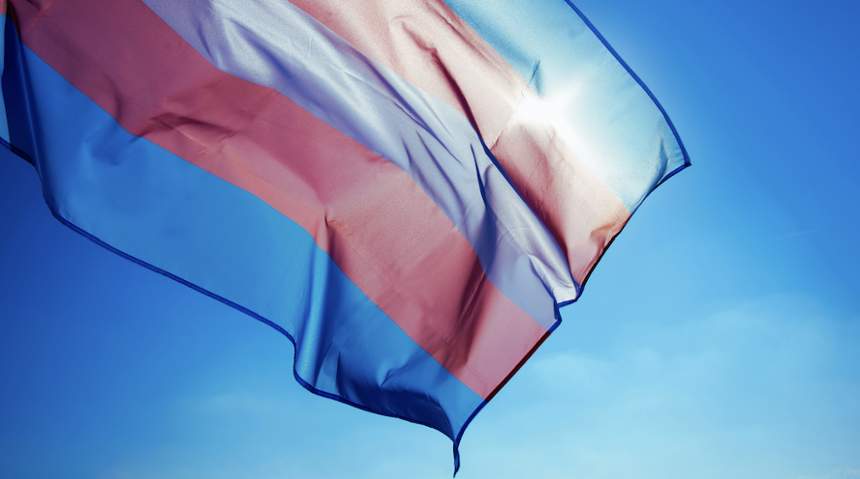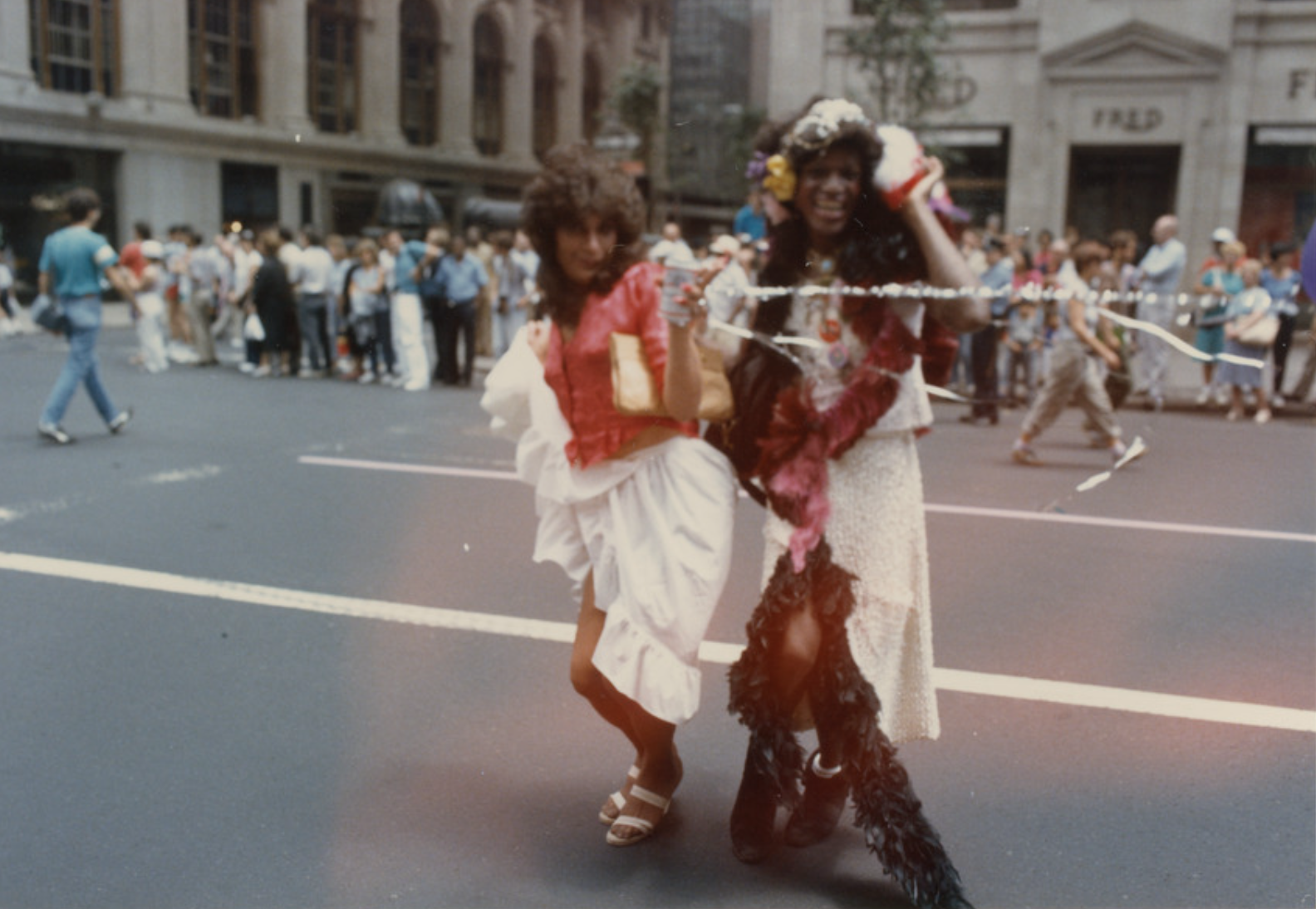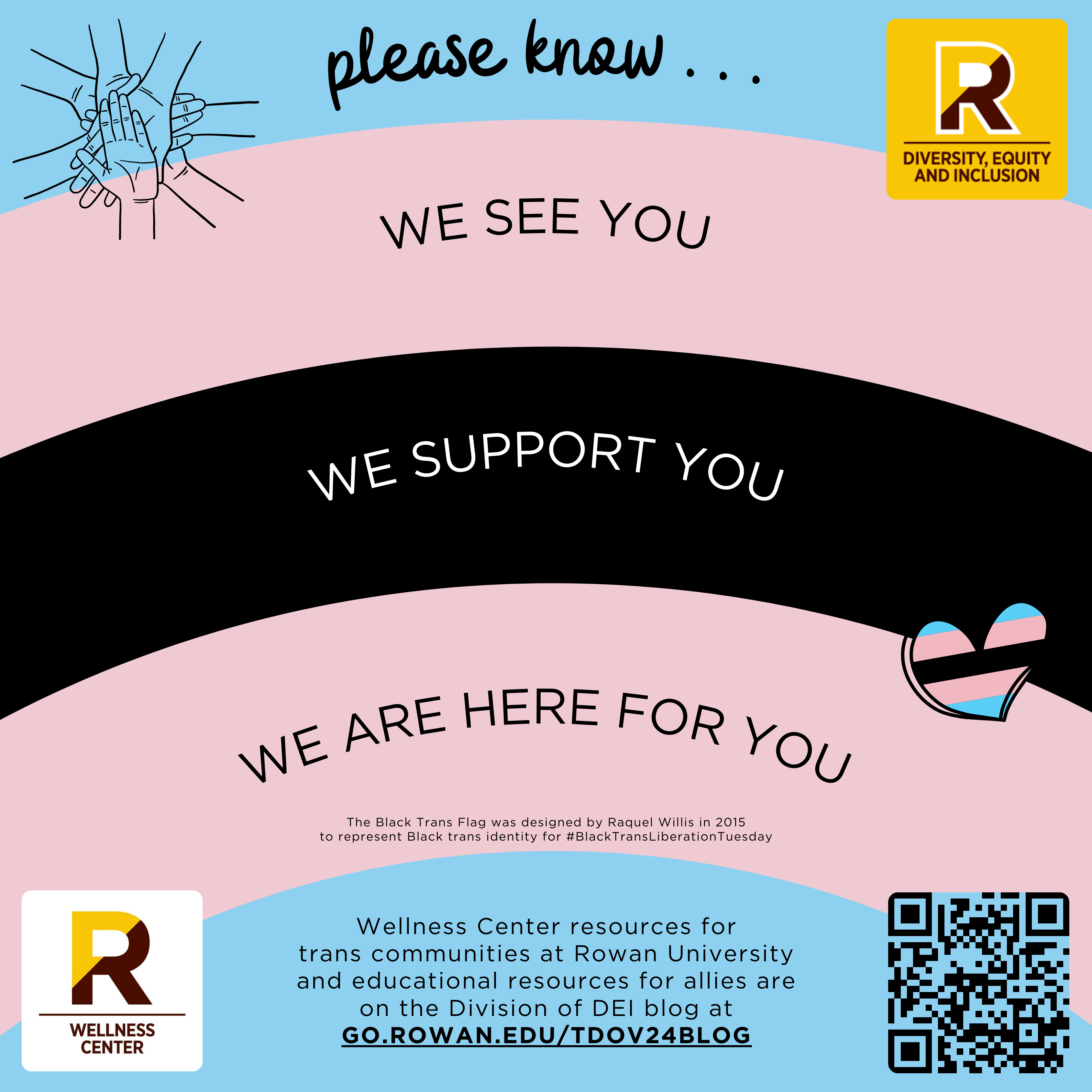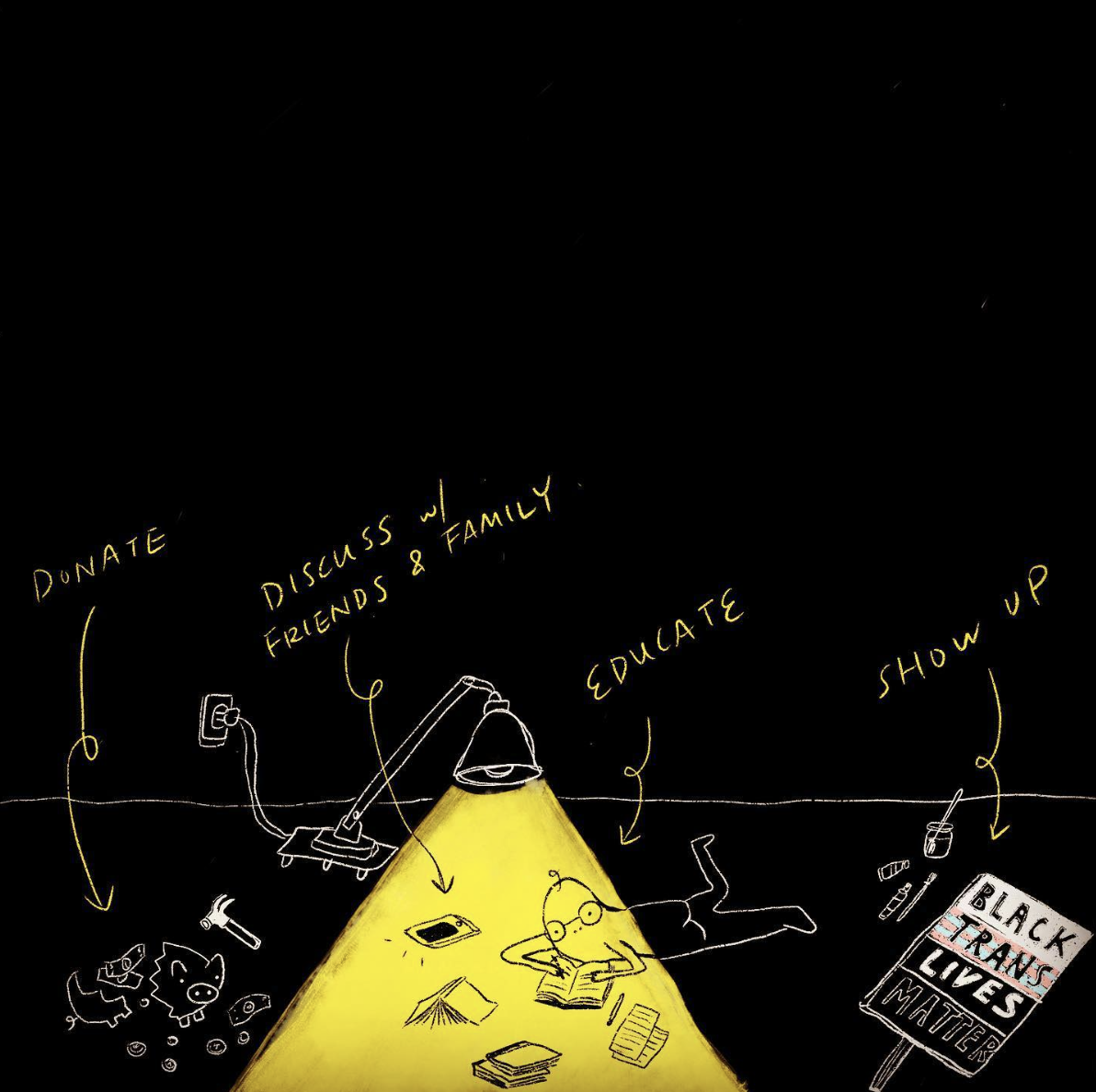
Image Alternative Text: A photograph of the Trans Pride Flag (shades of blue, pink, white) is depicted against a burst of sunlight and cerulean blue sky.
Click here to download the Rowan University Division of Diversity, Equity, and Inclusion (DEI) graphic flipbook honoring Trans Day of Visibility (TDOV) 2024 (abridged and social media shareable version of this article's contents).
This article was written by Patricia Fortunato (fortun83@rowan.edu) as part of the Rowan University Division of Diversity, Equity, and Inclusion (DEI) team.
With gratitude to our Rowan University community members for connection and collaboration on featured Rowan services and resources:
Romana C. Bresin, Ph.D., Licensed Psychologist and Coordinator of Gender, Relational, and Sexual Diversity Services at the Wellness Center for providing an overview of clinical services and resources; and Ann Vilinski, Ph.D., Licensed Psychologist and Associate Director of Counseling and Psychological Services for facilitating the connection;
Erwin Wambi, Undergraduate Student and Vice President of Shades of Unified Love (SOUL), a student-run safe space and advocacy group for queer people of color (QPOC), for providing an overview of upcoming student events, in collaboration with Kavin Haldo, Undergraduate Student and President of SOUL; and
MacK Reilly, Undergraduate Student and President of Prism, a student-run LGBTQIA+ organization that stands for educating the student body, advocating for members of the community, and supporting students, for providing an overview of upcoming student events
Contents are developed and produced with gratitude to the entire Division of DEI team; DEI Council; and LGBTQIA+ communities and allies at Rowan University.
Our Rowan University Division of Diversity, Equity, and Inclusion (DEI) team honors and supports Trans Day of Visibility (TDOV) today and every day, for our loved ones/families, friends, colleagues, students, and the entire Rowan University community and world at large. Together we strive to continuously promote intersectionality;1 advance trans-inclusive feminism; and build community among all individuals who identify as lesbian, gay, bisexual, trans/transgender, queer, intersex, and/or asexual+ (LGBTQIA+). As such, through educational content and communications that we develop and/or promote across the Division of DEI blog and social media platforms this week and year-round, we will strive to promote and advance these tenets for our readers and followers—students, academic faculty, staff, alumni, and the entire university community.
The American Medical Association (AMA) classified violence against trans people in the United States as an epidemic in 20192 and it persists.3 In 2023, in the U.S., at least 33 transgender and gender-expansive people were tragically lost to violence; 85% of victims were people of color; 69% were Black trans women; and 66.9% were misgendered by authorities and/or the press.3 The Human Rights Campaign (HRC) released a report of more than 11 years' data and community memories of the precious lives recorded as lost in the past year.3 Universal data released by Transgender Europe (TGEU) indicated 321 trans and gender-diverse people tragically lost to violence on a global level; 94% of victims were trans women or trans feminine people, and 80% trans or gender–diverse women of color.4
These individuals were all brave humans who helped to shape the world, and as a university community, we must strive to honor their memory with action, connecting with one another and uniting with a shared commitment to intentionally support, celebrate, and amplify Black trans women and all trans people.
We continue to call attention to all disparities impacting minoritized and marginalized people,1 and through our collaborations with the Wellness Center and student-run organizations, strive to better center Rowan University's LGBTQIA+ communities and support diverse connections and inclusive dialogue, and destigmatizing and compassionate services and resources.
Below, we offer educational information for allies and individuals striving towards allyship, including historical figures and symbols, and terms and guidance for continued learning; student-run events provided by SOUL and Prism; mental health services and support groups provided by the Wellness Center; and organizations to follow and support, as well as literature for continued learning. We will further publish content on our Division of DEI blog and social media platforms honoring Pride in coming weeks.
Follow the Rowan University Division of DEI:
- Instagram: instagram.com/rowandei
- Facebook: facebook.com/rowandei
- X/Twitter: twitter.com/rowandei
- Threads: threads.net/@rowandei
Honoring Marsha P. Johnson and Sylvia Rivera

Digital Transgender Archive. (1986). Sylvia Rivera (left) and Marsha P. Johnson (right) at Pride March, 1986. The LGBT Community Center. Retrieved from digitaltransgenderarchive.net/files/9019s278x on March 22, 2024.
The gay rights movement of the 1960s/70s and Pride were originally led by Marsha P. Johnson and Sylvia Rivera, trans women of color who advocated for universal acceptance of trans people and equal rights for all.5 Prior to her tragic death in 1992, Johnson gave an interview and reflected on George Segal's monument, Gay Liberation, stating, "How many people have died for these two little statues to be put in the park to recognize gay people? How many years has it taken for people to realize that we're all brothers and sisters and human beings and in the human race?"6
Rivera shared in her final essay, in 2002, "... one time I was walking across Sixth Avenue and she [Johnson] was standing there on the corner. She called me to her side, we introduced ourselves, and a very strong sistership was born. ... We stood by each other, had each other's back for many years."7 Johnson's and Rivera's legacies helped drive the ongoing fight for inclusive policies and access to social determinants of health (SDOH) and health equity for all trans people.
History of the Trans Pride Flag
Monica Helms, a trans woman and Navy veteran, created the Trans Pride Flag in 1999. She gave an interview in 2017, sharing that the pattern of traditional colors of blue and pink, and a stripe for people beyond the binary, "came to" her in a creative moment one morning.8
Helms' original flag creation was acquired by and displayed in the Smithsonian's National Museum of American History in 2014,9,10 and further included as part of a Smithsonian exhibit at the White House during Pride Month in 2016.11
Variations of the original Trans Pride Flag created by trans community members exist, including a Genderqueer Pride Flag, created in 2011 by Marilyn Roxie, a genderqueer writer and advocate. This version features a lavender/purple stripe at its top to represent androgyny; and the green stripe strives to represent people who do not identify with the traditional gender spectrum.12
Raquel Willis created the Black Trans Flag in 2015, designed to represent Black trans identity on #BlackTransLiberationTuesday.13 This day of action was led by Black trans organizers to call attention to violence against Black trans women. Willis advocated for this day of action to become an annual observance.14
The Intersex Inclusive Progress Pride Flag was most recently created in 2021, by Valentino Vecchietti of Intersex Equality Rights UK,15 who integrated the intersex community symbol as part of the Progress Pride Flag, an iteration of the Philadelphia Pride Flag created by Daniel Quaser.16
Terms and Guidance for Continued Learning
- Asexual: Asexual individuals experience little to no sexual attraction.
- Bisexual: Bisexual individuals are those whose emotional, sexual, or romantic attractions are to individuals of their gender or other gender identities.
- Cisgender: Cisgender individuals are those whose sex assigned at birth aligns with their gender identity.
- Gay: This term is used to describe individuals whose enduring attractions are to individuals of the same gender. Sometimes, the term lesbian is the preferred term for women. The term "homosexual" is derogatory and should not be used.
- Gender Expression: This term is used to describe physical manifestation of gender through clothing, voice, body shape, etc.
- Gender Fluid: This term is used to describe individuals whose identity shifts or fluctuates, including shifting between more than one gender and shifting between having a gender and not having one.
- Gender Neutral/Inclusive: This term is used to describe spaces and language that do not describe a specific gender. For example, gender-neutral restrooms can be used by any individual regardless of gender.
- Genderqueer: This term is used to describe individuals whose gender identity or expression are neither woman nor man, are between, beyond, or a combination of genders.
- Heterosexism: This term is used to describe a form of bias and discrimination that favors individuals who are exclusively romantically and/or sexually attracted to people of the opposite sex/gender.
- Intersex: This term is used to describe individuals who are born with a variation in their anatomy, chromosomes, or hormones that do not fit the predominant definitions of female or male. The term "hermaphrodite" is derogatory and should not be used as a synonym.
- Lesbian: This term is used for women whose emotional, sexual, or romantic attractions are primarily to other women.
- LGBTQIA+ Acronym: Lesbian, Gay, Bisexual, Trans/Transgender, Queer, Intersex, and Asexual+
- Misgendering: Misgendering is centered on labeling others as a gender that does not correctly reflect the gender with which they identify, including using pronouns that do not align with their gender. It is derogatory and can be stressful and traumatizing for individuals.17–23
- Misogyny and Trans-Misogyny: Misogyny is a general hatred and hostility towards women. Trans-misogyny is the same hatred and targeted at trans-feminine individuals.
- Non-Binary: Non-binary identities are not defined along the female/male binary. Non-binary individuals may feel that they exist as both, neither or a mix of identities.
- Pronouns: Gendered pronouns include she/her and he/him. Gender-neutral pronouns include the singular they/them and ze/hir. Many other pronouns exist as well. If unsure of someone's pronouns, simply ask, "What are your pronouns?" As a Rowan University community, we can create a more inclusive space within a group by introducing ourselves with our pronouns, and by sharing pronouns when communicating via email or other forms of communication. Research indicates that social gender affirmation through pronoun usage supports environments of belonging and safety,24 and reduces depression, suicidal ideation, and suicidal behavior particularly among trans and gender diverse adults and adolescents and young adults (AYA).25–27 In medicine, social gender affirmation and preferred pronoun usage, when utilized in conjunction with patient empowerment models, correlated with viral suppression among a study of trans women of color living with human immunodeficiency virus (HIV).28
- Queer: This is a reclaimed term used to self-identify as part of the LGBTQIA+ community. Not everyone uses this term as it can be used as a slur. Consider context before using this term. Queer may also be a distinct identity for individuals whose sexual orientation or gender identity are not adequately represented by other terms.
- Queer Theory: This theory explores dominant norms related to sexuality, and the harms they can cause to individuals who cannot or do not wish to follow dominant norms.
- Romantic Attraction: Romantic attraction is emotional connection to another individual that often involves a desire to be in a romantic relationship. Sexual attraction is not a requirement.
- Sex Assigned at Birth: This classification is of female, male, or intersex based on anatomy, chromosomes, and/or hormones. Sex does not define gender.
- Sexuality: Previously called "sexual orientation," sexuality is the direction of one's attraction. It is inappropriate to use the term "sexual preference."
- Trans/Transgender: These terms are used by individuals who do not identify as the gender that aligns with the sex they were assigned at birth. "Transvestite," "transsexual," and "transgendered" are derogotary and should not be used as synonyms.
- Two-Spirit/2S: This unique Indigenous identity embodies traits of both femininity and masculinity or of another gender than that assigned at birth.
From Shades of Unified Love (SOUL) at Rowan University
Shades of Unified Love (SOUL), previously known as Queer People of Color (QPOC), is a student-run organization that strives to create a safe space for queer students of color at Rowan University through identity-centered events. Upcoming events are detailed below.
- "Queer and BIPOC Literature" is being hosted in collaboration with Rowan University Libraries to showcase and share the rich narratives and powerful voices of queer and Black, Indigenous, and People of Color (BIPOC) authors, on Tuesday, April 2, 2024 from 6pm to 7:30pm in the Campbell Library, Room 138. The collaborative will strive to explore stories that challenge, inspire, and view the world through different lenses.
- "Colonization and Heteronormativity" is being hosted in collaboration with Rowan Progressives to illuminate a crucial, overlooked aspect of history and its impact on contemporary society, on Wednesday, April 10, 2024 at 7pm in the Chamberlain Student Center Pit. This educational gathering is designed to explore the complex ways in which colonization has shaped perceptions and behavior towards queer and trans individuals. The collaborative will delve into historical contexts, policies, and their lasting influence on education and media, and strive to educate the Rowan community and beyond.
From Prism at Rowan University
Prism is a student-run organization that strives to educate the student body, advocate for members of the community, and support LGBTQIA+ students. Upcoming events are detailed below.
- "Peace, Love, and Trans Rights" is taking place on Thursday, April 11, 2024 from 1pm to 5pm at the Owl Statues behind Savitz Hall. This gathering will allow both Prism members and the Rowan University community at large to meet and purchase shirts and tote bags to tie-dye and celebrate with music.
- "Rowan After Hours (RAH) x Prism Drag Show" is being hosted in collaboration with Rowan After Hours on Friday, April 12, 2024 from 9pm to 1am in the Chamberlain Student Center Pit. All Rowan students can enjoy free professional drag entertainment, play games, win prizes, and enjoy free snacks.

Image Alternative Text: The Black Trans Flag stripes (blue, pink, black) are depicted as the background. An illustrated group of hands meeting in support, and the Rowan University Division of Diversity, Equity, and Inclusion (DEI) logo, are positioned in the top corners of the graphic. The text cascades throughout the graphic and reads, "Please know… We support you. We believe in you. We are here for you always" followed by, "The Black Trans Flag was designed by Raquel Willis in 2015 to represent Black trans identity for #BlackTransLiberationTuesday." An illustrated heart with the same stripes is depicted alongside the text.
The text at the bottom of the graphic reads, "Wellness Center resources for trans communities at Rowan University and educational resources for allies are on the Division of DEI blog at go.rowan.edu/tdov24blog," with the Wellness Center logo and a QR code positioned in the bottom corners of the graphic.
Click here to download the graphic.
From the Rowan University Wellness Center
Counseling and Psychological Services Therapy and Support Groups for LGBTQIA+ Students:
- Trans Body Positive for students who identify as transgender or gender nonbinary
- In, Out, and In Between for students of any gender, sexual, or relational diversity identity
- Queer Collective for students, held at SJICR, intended to help students who are part of the LGBTQIA+ community meet one another, form connections, and support each other
Email wellnesscenter@rowan.edu or call 856.256.4333 to make an appointment
The Wellness Center also offers "Let's Talk" services—1:1, informal, confidential consultation that students can self–schedule at go.rowan.edu/RULetsTalk
Emergency Resources are open and available to all students of any gender, sexual, or relational identity:
- REACH Team counselors are available Mondays to Fridays to see students who are having a mental health emergency
- Students can walk into the Wellness Center or call and ask to speak to a counselor. go.rowan.edu/knowbeforeyougo
Student Health Services provides the following:
- Referrals within Rowan and the community, to specialists with expertise in caring for LGBTQIA+ students
- Acute care for medical concerns and minor injuries
- Reproductive health services in collaboration with FamCare, including testing and treatment for sexually transmitted infections (STI) and testing for human immunodeficiency virus (HIV)
Rowan University Community of Support
Rowan University students can submit complaints involving discrimination and harassment to the Office of Student Equity and Compliance (OSEC) at go.rowan.edu/titlevi
Rowan University employees can review how to submit complaints involving discrimination and harassment to the Office of Employee Equity (OEE) at sites.rowan.edu/equity
Resources for Continued Learning
Educational Guides and Toolkits:
- Pronouns.org. Pronouns Matter. Retrieved from pronouns.org on March 22, 2024.
- The Trevor Project. Guide to Being an Ally to Transgender and Nonbinary Young People. Retrieved from thetrevorproject.org/resources/guide/a-guide-to-being-an-ally-to-transgender-and-nonbinary-youth on March 22, 2024.
- Wamsley, L. (2021). A Guide to Gender Identity Terms. National Public Radio (NPR). Retrieved from npr.org/2021/06/02/996319297/gender-identity-pronouns-expression-guide-lgbtq on March 22, 2024.
Research Literature:
- Galupo, M. P., & Orphanidys, J. C. (2022). Transgender Black, Indigenous, and People of Color: Intersections of Oppression. International Journal of Transgender Health, 23(1–2), 1–4.
- Sevelius, J., Chakravarty, D., Neilands, T. B., Keatley, J., Shade, S. B., Johnson, M. O., ... & HRSA SPNS Transgender Women of Color Study Group. (2021). Evidence for the Model of Gender Affirmation: The Role of Gender Affirmation and Healthcare Empowerment in Viral Suppression Among Transgender Women of Color Living with HIV. AIDS and Behavior, 25, 64–71.
- Becerra, M. B., Rodriquez, E. J., Avina, R. M., & Becerra, B. J. (2021). Experiences of Violence and Mental Health Outcomes Among Asian American Transgender Adults in the United States. PLoS One, 16(3), e0247812.
- Fontanari, A. M. V., Vilanova, F., Schneider, M. A., Chinazzo, I., Soll, B. M., Schwarz, K., ... & Brandelli Costa, A. (2020). Gender Affirmation is Associated with Transgender and Gender Nonbinary Youth Mental Health Improvement. LGBT Health, 7(5), 237–247.
Other Literature:
- Álvarez, B. (2022). Why Pronouns Matter. National Education Association (NEA). Retrieved from nea.org/nea-today/all-news-articles/why-pronouns-matter on March 22, 2024.
- Sanchez, N. (2021). Trans Women Are Women: Avoiding the Mistakes of Our Predecessors. American Civil Liberties Union (ACLU). Retrieved from aclupa.org/en/news/trans-women-are-women-avoiding-mistakes-our-predecessors on March 22, 2024.
- Humphrey, K. (2020). Trans Rights Have Been Pitted Against Feminism But We're Not Enemies. The Guardian. Retrieved from theguardian.com/commentisfree/2020/jul/07/trans-rights-have-been-pitted-against-feminism-but-were-not-enemies on March 22, 2024.
Educational Podcasts:
- Jones, I. (Host). (2024). TransLash Podcast with Imara Jones. TransLash Media. Retrieved from translash.org/podcast on March 22, 2024.
- Rupp, L., & D'Emilio, J. (Hosts). (2024). Queer America Podcast Series. Southern Poverty Law Center (SPLC). Retrieved from learningforjustice.org/podcasts/queer-america on March 22, 2024.
- Ciesemier, K. (Host), Sherry, M. N., & Cooper, W. (2023). This Law Criminalizes Black Trans Women. At Liberty Podcast Episode, American Civil Liberties Union (ACLU). Retrieved from aclu.org/podcast/fighting-for-the-liberation-of-black-trans-women-in-louisiana on March 22, 2024.
Organizations to Follow and Support:

Image Alternative Text: Depicted is artwork by Chanel Miller. Illustrated words, "Donate," "Discuss w/ Friends & Family," "Educate," and "Show Up" are depicted, corresponding symbols, and a Black Trans Lives Matter sign, in shades of white, yellow, pink, blue, and black. The background of the image is black.
References
- Fortunato, P. (2024). Recognizing and Celebrating Women's History Month and International Women's Day Year-Round. Rowan University. Retrieved from sites.rowan.edu/diversity-equity-inclusion/blog/2024/march/womens-history-month.html on March 22, 2024.
- American Medical Association (AMA). (2019). AMA Adopts New Policies on First Day of Voting at 2019 Annual Meeting. AMA. Retrieved from ama-assn.org/press-center/press-releases/ama-adopts-new-policies-first-day-voting-2019-annual-meeting on March 22, 2024.
- Human Rights Campaign (HRC) Foundation. (2023). The Epidemic of Violence Against the Transgender and Gender Non–Conforming Community in the United States. HRC. Retrieved from reports.hrc.org/an-epidemic-of-violence-2023 on March 22, 2024.
- Transrespect Versus Transphobia Worldwide (TVT) (2023). Trans Murder Monitoring 2023 Global Update. TVT. Retrieved from transrespect.org/en/research/tmm on March 22, 2024.
- Smithsonian Sparks. (2021). Marsha Johnson, Sylvia Rivera, and the History of Pride Month. Smithsonian. Retrieved from si.edu/stories/marsha-johnson-sylvia-rivera-and-history-pride-month on March 22, 2024.
- Kasino, M., & Morrison, R. (Directors). (2012). Pay It No Mind: Marsha P. Johnson. [Video].
- Rivera, S. (2002). Queens in Exile: The Forgotten Ones. GenderQueer: Voices from Beyond the Sexual Binary. Alyson Books.
- Allen, S. (2017). "Divine Intervention" Helped Monica Helms Create the Transgender Pride Flag. The Daily Beast.
- Smithsonian Sparks. (2022). Who Designed the Transgender Flag? Smithsonian. Retrieved from si.edu/stories/who-designed-transgender-flag on March 22, 2024.
- Helms, M. (1999). Miniature Transgender Pride Flag. Smithsonian. Retrieved from americanhistory.si.edu/collections/nmah_1694623 on March 22, 2024.
- Goldberg, A. E., & Beemyn, G. (Eds.). (2021). The SAGE Encyclopedia of Trans Studies. SAGE Publications, Incorporated.
- Roxie, M. (2011). Genderqueer Pride Flag. Retrieved from marilynroxie.com/GENDERQUEER-FLAG on March 22, 2024.
- Willis, R. @RaquelWillis_. Twitter, November 21, 2020, twitter.com/RaquelWillis_/status/1330300065970335744.
- Willis, R. (2016). Black Trans Liberation Tuesday Must Become an Annual Observance. Rewire News Group. Retrieved from rewirenewsgroup.com/2016/08/23/black-trans-liberation-tuesday-must-be-annual on March 22, 2024.
- Vecchietti, V. (2021). Intersex Inclusive Progress Pride Flag. Retrieved from instagram.com/p/CQNfn_PFxI8 on March 22, 2024.
- Qasar, D. (2018). Progress Pride Flag. Retrieved from progress.gay on March 22, 2024.
- Jacobsen, K., Davis, C. E., Burchell, D., Rutherford, L., Lachowsky, N., Bauer, G., & Scheim, A. (2023). Misgendering and the Health and Wellbeing of Nonbinary People in Canada. International Journal of Transgender Health, 1–15.
- Cardona, N. D., Madigan, R. J., & Sauer-Zavala, S. (2022). How Minority Stress Becomes Traumatic Invalidation: An Emotion-Focused Conceptualization of Minority Stress in Sexual and Gender Minority People. Clinical Psychology: Science and Practice, 29(2), 185.
- Puckett, J. A., Price, S. F., Mocarski, R., Mustanski, B., & Newcomb, M. E. (2022). Transgender and Gender Diverse Individuals' Daily Experiences of Rumination. American Journal of Orthopsychiatry, 92(5), 540.
- Alpert, A. B., Mehringer, J. E., Orta, S. J., Redwood, E., Hernandez, T., Rivers, L., ... & Griggs, J. J. (2023). Experiences of Transgender People Reviewing Their Electronic Health Records, a Qualitative Study. Journal of General Internal Medicine, 38(4), 970–977.
- Lindley, L., & Budge, S. L. (2022). Development and Validation of the Trans and Nonbinary Coping Measure (TNCM): A Measure of Trans and Nonbinary Specific Ways of Coping with Gender-Related Stress. Psychology of Sexual Orientation and Gender Diversity.
- Puckett, J. A., Aboussouan, A. B., Ralston, A. L., Mustanski, B., & Newcomb, M. E. (2023). Systems of Cissexism and the Daily Production of Stress for Transgender and Gender Diverse People. International Journal of Transgender Health, 24(1), 113–126.
- McLemore, K. A. (2018). A Minority Stress Perspective on Transgender Individuals' Experiences with Misgendering. Stigma and Health, 3(1), 53.
- Sevelius, J. M., Chakravarty, D., Dilworth, S. E., Rebchook, G., & Neilands, T. B. (2020). Gender Affirmation Through Correct Pronoun Usage: Development and Validation of the Transgender Women's Importance of Pronouns (TW-IP) Scale. International Journal of Environmental Research and Public Health, 17(24), 9525.
- Glynn, T. R., Gamarel, K. E., Kahler, C. W., Iwamoto, M., Operario, D., & Nemoto, T. (2016). The Role of Gender Affirmation in Psychological Well-Being Among Transgender Women. Psychology of Sexual Orientation and Gender Diversity, 3(3), 336.
- Hughto, J. M., Gunn, H. A., Rood, B. A., & Pantalone, D. W. (2020). Social and Medical Gender Affirmation Experiences are Inversely Associated with Mental Health Problems in a US Non-Probability Sample of Transgender Adults. Archives of Sexual Behavior, 49, 2635–2647.
- Fontanari, A. M. V., Vilanova, F., Schneider, M. A., Chinazzo, I., Soll, B. M., Schwarz, K., ... & Brandelli Costa, A. (2020). Gender Affirmation is Associated with Transgender and Gender Nonbinary Youth Mental Health Improvement. LGBT Health, 7(5), 237–247.
- Sevelius, J., Chakravarty, D., Neilands, T. B., Keatley, J., Shade, S. B., Johnson, M. O., ... & HRSA SPNS Transgender Women of Color Study Group. (2021). Evidence for the Model of Gender Affirmation: The Role of Gender Affirmation and Healthcare Empowerment in Viral Suppression Among Transgender Women of Color Living with HIV. AIDS and Behavior, 25, 64–71.